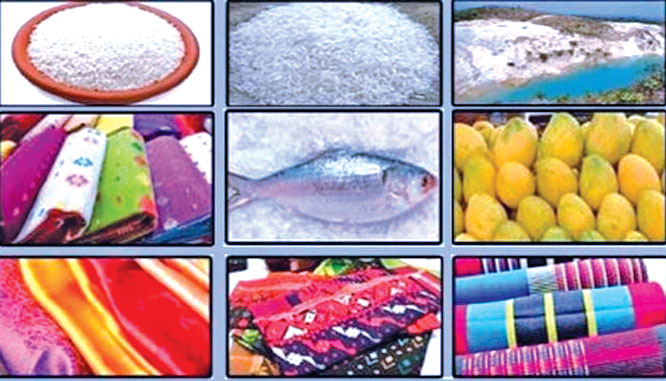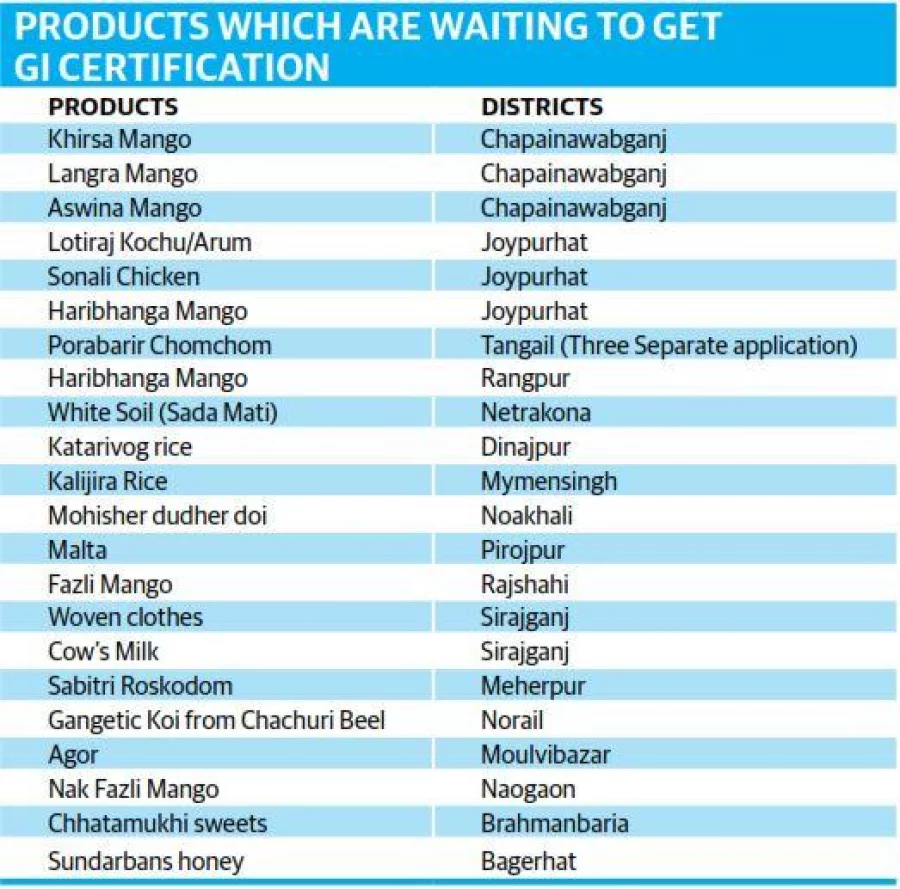The list of Geographical Indication (GI) products in Bangladesh includes Rosogolla of Gopalganj, Porabari chomchom of Tangail, Rosomalai of Cumilla, Teeler khaja of Kushtia, Black Bengal Goat, Haribhanga mango of Rangpur, Agar of Moulvibazar, Agar ator of Moulvibazar, Monda of Muktagacha, Date jaggery of Jashore, Sweet betel leaf of Rajshahi, and Nakshi Kantha of Jamalpur. Other notable GI-approved products in Bangladesh are Muslin from Dhaka, Jamdani Saree, Rajshahi Silk, Tangail Saree, Bangladesh Hilsa, Kataribhog Rice from Dinajpur, Kalijira Rice of Bangladesh, Shotoronji of Rangpur, and Fazli Mango from Rajshahi.
These products have received official recognition and protection for their specific geographical origin and unique qualities.
Introduction To Bangladesh’s Gi Products
Bangladesh is renowned for its diverse range of Geographical Indication (GI) products, each carrying a unique cultural and historical significance. These products are deeply rooted in the country’s heritage and contribute significantly to its economy and global reputation. In this article, we will delve into the significance of GI status, explore a brief history of GI products in Bangladesh, and highlight some of the iconic items that have received GI certification.
The Significance Of Gi Status
Obtaining Geographical Indication (GI) status is a significant achievement for products as it offers legal protection and helps in preserving their authenticity, quality, and distinct characteristics. This recognition also plays a crucial role in promoting rural economic development and empowering local communities.
A Brief History Of Gi Products In Bangladesh
The journey of GI products in Bangladesh dates back to ancient times, where traditional craftsmanship and indigenous knowledge gave rise to unique items that gained recognition for their exceptional quality and cultural importance. Over the years, these products have evolved into symbols of national pride and heritage, captivating both domestic and international markets.
The Culinary Delights
When it comes to culinary delights, Bangladesh offers a rich tapestry of flavors and delicacies. From the sweet confections to the succulent fruits, the country boasts a diverse range of Geographical Indication (GI) products that are sure to tantalize the taste buds and leave a lasting impression.
Rosogolla Of Gopalganj
The famous Rosogolla of Gopalganj is a cherished sweet treat that has gained recognition for its unique taste and texture. Made from chhana (cottage cheese) and dipped in sugary syrup, this iconic dessert is a must-try for anyone with a sweet tooth.
Porabari Chomchom Of Tangail
Another delectable delight is the Porabari chomchom of Tangail, known for its lusciousness and traditional preparation. The soft, syrup-soaked chomchom is a beloved dessert that has secured its place as a symbol of Tangail’s culinary heritage.
Teeler Khaja Of Kushtia
Kushtia’s Teeler khaja is a sweet pastry that holds a special place in the hearts of dessert enthusiasts. Its delicate layers and aromatic flavors make it a standout treat that showcases the artistry of Kushtia’s culinary craftsmanship.
Haribhanga Mango Of Rangpur
The Haribhanga mango of Rangpur is a tropical delight that embodies the essence of the region’s fertile orchards. With its succulent flesh and aromatic sweetness, this mango variety has earned its reputation as a premium fruit with unparalleled flavor.
Date Jaggery Of Jashore
Jashore’s Date jaggery is a natural sweetener that adds a distinctive flavor to various dishes and desserts. The traditional method of preparing this jaggery ensures a rich, caramel-like taste that sets it apart as a prized ingredient in Bengali cuisine.
Textiles And Fabrics
Discover the diverse range of textiles and fabrics offered in the Gi Product List Bangladesh. From iconic Muslin to Jamdani Saree and Rajshahi Silk, Bangladesh boasts a rich heritage of GI-approved products, including Hilsa, Kalijira Rice, and Fazli Mango. These unique items showcase the country’s vibrant cultural and economic significance.
Muslin From Dhaka
Textiles and fabrics hold a significant place in the list of Geographical Indication (GI) products of Bangladesh. Among the most iconic textiles that have obtained GI status is the Muslin from Dhaka. Muslin is a handwoven cotton fabric that is known for its fine texture and luxurious feel. It has been a significant part of the Bengali culture for centuries. The GI recognition has helped to preserve the traditional method of Muslin weaving, which was on the verge of extinction. The Muslin from Dhaka has gained worldwide recognition for its quality and has become a symbol of Bangladeshi heritage.Jamdani Saree
Another traditional fabric that has obtained GI status is the Jamdani Saree. It is a handloom woven fabric made of cotton and gold or silver threads. The intricate designs of Jamdani Saree are made by adding extra weft threads while weaving. The patterns are inspired by nature and are a reflection of the rich cultural heritage of Bengal. Jamdani Saree has become popular among women worldwide due to its unique and intricate designs.Rajshahi Silk
Rajshahi Silk is a luxurious fabric made of pure silk. The silk is produced by the silkworms reared in the Rajshahi region of Bangladesh. The fabric is known for its softness, durability, and natural sheen. The GI recognition has helped to promote the traditional method of silk production, which is eco-friendly and sustainable. Rajshahi Silk has become a symbol of elegance and sophistication in the fashion industry.Tangail Saree
Tangail Saree is a handloom woven cotton fabric that has obtained GI status. The fabric is known for its unique designs and patterns that are inspired by nature. The Tangail Saree is famous for its lightness and comfort, making it a popular choice among women. The GI recognition has helped to preserve the traditional method of Tangail Saree weaving, which was on the verge of extinction. Today, the Tangail Saree has become a significant part of the Bengali culture and a symbol of Bangladeshi heritage. In conclusion, the textile and fabric industry in Bangladesh has a rich cultural heritage that has been recognized globally through the GI status. The GI recognition has helped to preserve and promote the traditional methods of textile production, which is eco-friendly and sustainable. The Muslin from Dhaka, Jamdani Saree, Rajshahi Silk, and Tangail Saree are some of the iconic textiles that have obtained GI status and have become symbols of Bangladeshi heritage.
Credit: www.cbgabd.org
Agricultural Marvels
Bangladesh is known for its rich agricultural heritage, boasting an array of remarkable products that have gained international recognition. From the renowned Black Bengal Goat to the exquisite Agar of Moulvibazar and the flavorful Kataribhog Rice from Dinajpur, the country’s agricultural marvels are a testament to its diverse and thriving agricultural industry. Let’s delve into the fascinating details of these remarkable products:
Black Bengal Goat
The Black Bengal Goat is a breed indigenous to Bangladesh and is highly regarded for its meat and milk production. This goat breed is well-adapted to the country’s climate and is known for its high fertility rate and resistance to diseases. The meat from the Black Bengal Goat is tender, succulent, and has a distinct flavor, making it a sought-after delicacy both locally and internationally.
Agar Of Moulvibazar
Moulvibazar, a district in Bangladesh, is famous for its production of Agar, a valuable resinous substance derived from the Aquilaria tree. Agar has a unique fragrance and is widely used in the perfume and incense industries. The Agar of Moulvibazar is highly prized for its exceptional quality and aroma, making it a significant export commodity for the country.
Kataribhog Rice From Dinajpur
Dinajpur, a region in Bangladesh, is renowned for its Kataribhog Rice. This aromatic rice variety is known for its distinct flavor, long grain, and excellent cooking properties. Kataribhog Rice is a favorite among rice connoisseurs and is highly sought after for its premium quality and taste. It is often used to prepare traditional Bengali dishes and is a staple in many households across the country.
Kalijira Rice Of Bangladesh
The Kalijira Rice of Bangladesh is a unique and flavorful rice variety that is popular for its small, slender grains and delicate texture. It is often referred to as “baby rice” due to its miniature size. Kalijira Rice is highly aromatic and has a slightly sweet taste, making it a preferred choice for special occasions and festive meals. Its distinctive flavor and versatility in various culinary preparations have earned it a special place in the hearts and plates of many Bangladeshis.
These agricultural marvels of Bangladesh not only contribute to the country’s economy but also showcase the rich agricultural heritage and diversity of the region. With their unique qualities and exceptional taste, these products continue to enchant both locals and international consumers, making them an integral part of Bangladesh’s agricultural success story.
Unique Flavors And Fragrances
Discover the unique flavors and fragrances of the GI product list in Bangladesh, including Rosogolla of Gopalganj, Teeler khaja of Kushtia, and Nakshi Kantha of Jamalpur. These products showcase the rich cultural heritage and diverse traditional craftsmanship of Bangladesh.
Unique Flavors and Fragrances are the hallmarks of Bangladeshi GI products. From the sweet betel leaf of Rajshahi to the agar ator of Moulvibazar, each product boasts a distinct aroma and taste that sets it apart. Let’s explore some of the most unique flavors and fragrances that GI Product List Bangladesh has to offer:Agar Ator Of Moulvibazar
Agar ator is a type of agarwood oil that is extracted from the agar tree found in Moulvibazar district. It has a rich, woody aroma with hints of sweetness, making it a popular ingredient in perfumes and incense.Sweet Betel Leaf Of Rajshahi
The sweet betel leaf of Rajshahi is a type of paan leaf that is known for its distinct flavor and aroma. It has a sweet, minty taste with a slightly bitter aftertaste. The leaf is often used to make paan, a popular after-dinner treat in Bangladesh.Shotoronji Of Rangpur
Shotoronji is a type of citrus fruit that is found in Rangpur district. It has a tangy, sour taste with a hint of sweetness, making it a popular ingredient in chutneys and pickles.Fazli Mango From Rajshahi
Fazli Mango is a variety of mango that is grown in Rajshahi district. It has a sweet, juicy taste with a strong aroma, making it one of the most popular mango varieties in Bangladesh. Overall, the Unique Flavors and Fragrances of Bangladeshi GI products make them stand out in the global market. From sweet to sour, woody to fruity, there is a flavor and fragrance for everyone to enjoy.
Credit: www.researchgate.net
The Craftsmanship
Discover the exquisite craftsmanship of GI products in Bangladesh, including the iconic Muslin from Dhaka, Jamdani Saree, Rajshahi Silk, and other unique items like Nakshi Kantha from Jamalpur. These Geographical Indication-approved products showcase the rich cultural heritage and skilled artistry of Bangladesh.
Nakshi Kantha Of Jamalpur
Gi Product List Bangladesh is a treasure trove of exquisite crafts. One such masterpiece is the Nakshi Kantha of Jamalpur, a type of embroidered quilt. This traditional art is passed down from generation to generation of skilled artisans who work tirelessly to create intricate patterns and designs on the fabric. The Nakshi Kantha is not just a piece of cloth, but a story that tells the history and culture of Bangladesh.The Art Of Monda Of Muktagacha
Another piece of art that deserves recognition is the Monda of Muktagacha. It is a type of sweetmeat made from chhana (cottage cheese) and sugar syrup. The process of making Monda is a meticulous one that requires precision and expertise. The chhana is kneaded, shaped, and cooked to perfection before being dipped in syrup. Each Monda is a work of art, with a unique design that reflects the skill and creativity of the maker. Gi Product List Bangladesh is a testament to the craftsmanship and creativity of the Bangladeshi people. From the Nakshi Kantha of Jamalpur to the Monda of Muktagacha, every product is a masterpiece that reflects the rich cultural heritage of the country. These products are not just items to be bought and sold, but a symbol of the hard work and dedication of the artisans who create them. It is no wonder that these products have gained international recognition and are sought after by people all over the world.New Additions To The Gi List
Introducing the latest additions to the GI Product List Bangladesh, including the renowned Haribhanga Mango from Rangpur, Agar from Moulvibazar, Agar Atar from Moulvibazar, and Monda (Sweetmeat) from Muktagacha. These products have obtained Geographical Indication (GI) status, showcasing the rich cultural heritage of Bangladesh.
The Significance Of New Entries
Adding new products to the GI (Geographical Indication) list is a significant development for Bangladesh. It not only expands the range of protected products but also boosts the country’s cultural heritage and economic growth. These new additions showcase the unique and traditional craftsmanship, flavors, and agricultural produce of different regions in Bangladesh.
Exploring The Latest Gi Approved Products
Let’s take a closer look at the latest additions to the GI list in Bangladesh:
- Rosogolla of Gopalganj: A mouthwatering sweet delicacy originating from Gopalganj, known for its spongy texture and delectable taste.
- Porabari Chomchom of Tangail: This sweet treat from Tangail is famous for its cylindrical shape and rich flavor, making it a favorite among dessert lovers.
- Rosomalai of Cumilla: A creamy and velvety dessert made with clotted cream and flavored with cardamom, originating from Cumilla.
- Teeler Khaja of Kushtia: These crispy and flaky sweet snacks, made with sesame seeds and jaggery, are a specialty of Kushtia.
- Black Bengal Goat: This indigenous breed of goat from Bangladesh is known for its high-quality meat and plays a vital role in the country’s livestock industry.
- Haribhanga Mango of Rangpur: Rangpur’s Haribhanga mangoes are renowned for their juicy flesh, aromatic flavor, and vibrant color, making them a popular choice among mango enthusiasts.
- Agar of Moulvibazar: Moulvibazar’s Agar, commonly known as agarwood or oud, is highly valued for its fragrance and is widely used in perfumes, incense, and medicinal products.
- Agar Ator of Moulvibazar: Agar Ator, a byproduct of Agarwood, is used in traditional medicines and has a distinctive aroma.
- Monda of Muktagacha: Muktagacha’s Monda is a traditional sweetmeat made from reduced milk, sugar, and various flavorings, offering a delightful taste experience.
- Date Jaggery of Jashore: Jashore’s Date Jaggery is a natural sweetener made from the sap of date palm trees, known for its unique flavor and nutritional benefits.
- Sweet Betel Leaf of Rajshahi: Rajshahi’s Sweet Betel Leaf is cherished for its refreshing aroma and is commonly used in paan preparations, symbolizing hospitality and cultural traditions.
- Nakshi Kantha of Jamalpur: Jamalpur’s Nakshi Kantha is a traditional embroidered quilt, showcasing intricate designs and artistic craftsmanship, reflecting the cultural heritage of the region.
These new additions to the GI list not only protect the authenticity and quality of these products but also promote them both domestically and internationally, contributing to the economic prosperity of Bangladesh.
The Impact Of Gi Products On Bangladesh
The impact of GI products on Bangladesh is significant, as it showcases the country’s rich cultural heritage and promotes economic growth. The GI product list in Bangladesh includes iconic items such as Muslin, Jamdani Saree, Rajshahi Silk, and unique food items like Bangladesh Hilsa and Kataribhog Rice.
These products contribute to the country’s economic diplomacy and highlight the craftsmanship and culinary excellence of Bangladesh.
Boosting The Economy Through Gi Products
Geographical Indication (GI) products have a significant impact on the economy of Bangladesh. The GI products of Bangladesh have gained global recognition and popularity, which has led to the growth of exports. This, in turn, has boosted the economy of the country. The Ministry of Foreign Affairs has listed several GI products, including the iconic Muslin from Dhaka, Jamdani Saree, Rajshahi Silk, Tangail Saree, Bangladesh Hilsa, Kataribhog Rice from Dinajpur, Kalijira Rice of Bangladesh, Shotoronji of Rangpur, Fazli Mango from Rajshahi, and Nakshi Kantha of Jamalpur. These products have played a vital role in the growth of Bangladesh’s economy.Cultural Significance And Global Recognition
Apart from boosting the economy, GI products also hold cultural significance and have gained global recognition. Bangladesh is a country rich in culture and heritage, and the GI products are a reflection of its traditions. The GI products of Bangladesh are unique, handcrafted, and have been passed down through generations. Some of the notable GI-approved products in Bangladesh are the iconic Muslin from Dhaka, Jamdani Saree, Rajshahi Silk, Tangail Saree, Bangladesh Hilsa, Kataribhog Rice from Dinajpur, Kalijira Rice of Bangladesh, Shotoronji of Rangpur, Fazli Mango from Rajshahi, and Nakshi Kantha of Jamalpur. These products have gained global recognition and are highly valued for their cultural significance. They represent the rich heritage and traditions of Bangladesh, and their popularity has only increased over time. In conclusion, GI products have a significant impact on the economy and culture of Bangladesh. They have gained global recognition and popularity, and their value has only increased over time. Bangladesh should continue to promote and protect its GI products to ensure their continued success and growth.
Credit: www.bssnews.net
Frequently Asked Questions
What Are The 14 Gi Products Of Bangladesh?
There are 14 GI products in Bangladesh, including Rosogolla of Gopalganj, Porabari chomchom of Tangail, Rosomalai of Cumilla, Teeler khaja of Kushtia, Black Bengal Goat, Haribhanga mango of Rangpur, Agar of Moulvibazar, Agar ator of Moulvibazar, Monda of Muktagacha, Date jaggery of Jashore, Sweet betel leaf of Rajshahi, and Nakshi Kantha of Jamalpur.
What Is The 21 Gi Product In Bangladesh?
The 21 GI products in Bangladesh include Gopalganj’s Rosogolla, Tangail’s Porabari Chomchom, Cumilla’s Rosomalai, Kushtia’s Teeler Khaja, Black Bengal Goat, Rangpur’s Haribhanga Mango, Moulvibazar’s Agar and Agar Ator, Muktagacha’s Monda, Jashore’s Date Jaggery, Rajshahi’s Sweet Betel Leaf, and Jamalpur’s Nakshi Kantha.
These products have obtained Geographical Indication (GI) status in Bangladesh.
How Many Gi Products Of Bangladesh 2024 List?
Bangladesh has 27 Geographical Indication (GI) products listed for 2024. These include Nakshi Kantha, Haribhanga Mango, and Tangail Saree.
What Is The 17 Gi Product In Bangladesh?
The 17 GI products in Bangladesh include Rosogolla from Gopalganj, Porabari chomchom from Tangail, and Haribhanga mango from Rangpur. These products have received Geographical Indication (GI) status.
Conclusion
Bangladesh boasts a diverse range of Geographical Indication (GI) products that showcase the country’s rich cultural heritage and craftsmanship. From the iconic Muslin fabric to the delectable Hilsa fish, each GI product represents the unique traditions and expertise of different regions in Bangladesh.
With recent additions like the Haribhanga Mango, Agar, and Monda, the list continues to grow, reflecting the country’s commitment to preserving and promoting its distinctive products. These GI products not only contribute to Bangladesh’s economy but also serve as a source of national pride.



